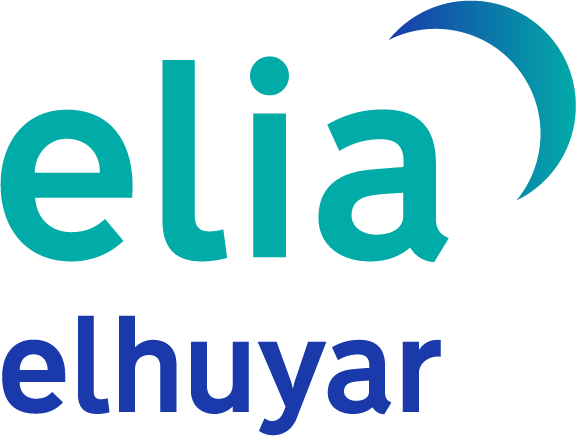Introduction
Digitalization was expected to exacerbate forms of communication and entertainment, but few could expect social media to revolutionize the way news is consumed and young people to play a decisive role in this process. This is the objective of this article to delve into the new forms of information consumption. Thus, in the following lines we will discuss the relationship of young people with information, based on the results of the Digital News Report 2023, published by the Reuters Institute. In addition, we will present the results of the research carried out by Ikusiker Behstrategy in 2023 on this subject, to better understand the sources of information, the type of content and the formats chosen by the young people of Hego Euskal Herria from 11 to 23 years old.
Information in the digital age
Digitisation has been more than just a technical change. In addition to communicating and entertaining, the ways of being informed have changed radically. The production of content, work routines, supports and business models are undergoing a continuous and far-reaching transformation that logically affects people’s information consumption models (Yuste, 2020). Information and Communication Technologies (ICT) have also acquired a major role in people’s interaction, leisure use, cultural transmission, the creation and dissemination of information.
Information channels and formats have been reinvented and traditional information sources, such as television, radio and newspapers, have tried to adapt to the new times, as digital technologies, the Internet, and especially social networks, offer young people a very different media ecosystem.
The Digital News Report 2023, published by the Reuters Institute, notes that the war in Ukraine and the resulting economic impact have accelerated the transition from the media to the digital, which has been reflected in business models, types of narration and even new forms of distribution. At the same time, digitalisation has led to the decline of some media. For example, newspapers that have been a source of preferential and reference information for many generations have failed to attract more young people to paper information, so there has not been a balanced correlation between expected generations (Casero-Ripollés, 2012).
Over the past ten years, traditional media have seen a steady decline in most markets, both on television and in the print media. In Germany, for example, in a country with very traditional media behaviors, weekly consumption of the written press dropped from 63% to 26% in this decade, and from television news from 82% to 65% (Newman 2023).
However, the Reuters Institute report points out that the use of online media information (74%) has decreased by five percentage points compared to 2022 and that the distance to information consumption of all traditional offline media has decreased, keeping their audience (69%). It appears, therefore, that digitisation has not yet caused an absolute decline in traditional media.
Nicholas Carrek Superficial. Zer egiten ari da Internet (2017) points out that from the moment information is digitized, the boundaries between the media fade, information becomes omnipresent and tends to become omniscient. Consumers decide when to access information. There are no more schedules, only requests.
In this sense, digitalisation has changed the meaning of being informed. The agenda setting theory says that its function is to set important issues in the public sphere (the public), but it seems that, today, it is more related to providing practical information for people’s daily lives, that is, with mere availability.
In this context, social networks are gaining space and prominence among the increasingly demanding young (Bonales-Daimiel et al., 2021). They manage to create a continuous flow of information exchange for each user to provide their opinion and, therefore, allow interaction with the new one. The receiver of the information, whether reader, listener or viewer, has the possibility of being an active user.
Although search engines, websites and social networks play different roles, in recent years they have been the main access to news, especially among young people. But more and more suppliers have joined the competition for information. As audio and video are becoming more successful, new platforms based on them have been included in the game, and some consumers have opted for these new providers, among which young people stand out.
The following graph shows how in recent years social networks have become a preferred source of information (30%), ahead of traditional media websites and applications (22%).

Research by the Reuters Institute also reveals the success of the Tik Tok social network. This Chinese-owned network reaches 44% of people aged 18-24 (in all markets considered for research) and 20% in the use of information. However, Facebook is the most used network as a source of information, with 28%, although it is now 14 points below the 42% obtained in 2016. Facebook has been moving away from the press for years, reducing the percentage of news that people see in their feed, and reducing direct payments to media and other journalism support programs in the past year. Tik Token’s rise demonstrates the growing strength of video-centric social media.
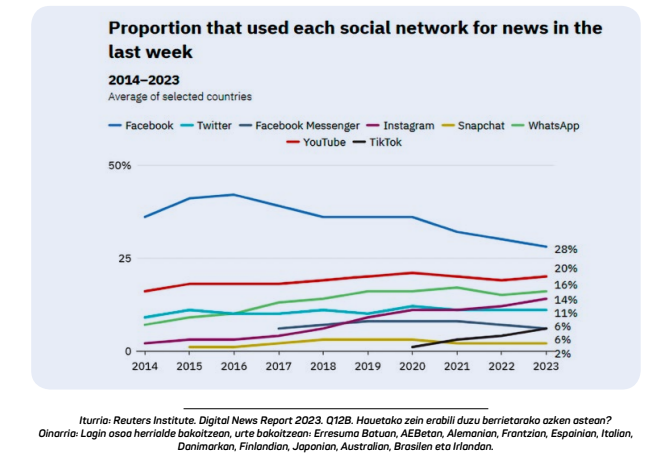
And in this new context, is information a favorite field for young people?
Data from the 2023 edition of the report we take as reference show that interest in news has been declining among youth in most countries of the world. Overall, it has been declining, from 63% in 2017 to 51% in 2022. In the Spanish state, for example, interest in news decreases by 30 points, from 85% in 2015 to 55% in 2022. Thus, knowledge and understanding of the consumption trends of those who in the coming years will represent more than a third of the world"s population (Bethlehem Z) is essential. Therefore, in 2023 Ikusiker began the study Juventud e Información to analyze the relationship of the young people of Hego Euskal Herria between 11 and 23 years with the information.
Methodology
Ikusiker Behstrategy, which analyzes audiovisual consumption and the uses of ICT, has two complete panels with young people from Hego Euskal Herria. The first, between 11 and 17 years of high school, and the second, of the students from 18-23.
In the 2022-2023 ESO panel, there are students from the ten educational centers, very diverse in terms of the type of space and school. In Álava dos (IES Vitoria-Gasteiz Oeste and Egibide Ikastetxea), in Bizkaia three (IES Unamuno de Bilbao, Ikastola Larramendi de Mungia and IES Ondarroa), in Gipuzkoa dos (IES Arizmendi Alarteastmen de Eskoriatza) The fieldwork for the secondary panel was carried out in two moments, in autumn 2022 (October and November) and in spring 2023 (March and April), using two questionnaires created for this purpose.
On the other hand, over two thousand six hundred students from the University of the Basque Country (UPV/EHU) and the Public University of Navarra (UPNA) converge in the panel of university students. The sample includes young people from different territories, areas of knowledge, faculties and studies. As for fieldwork, at the beginning of the course, the first face-to-face survey is carried out in classrooms and from there, the following seven questionnaires are sent to students who agree to participate in the panel on a monthly basis.
IP and university questionnaires are designed on the survey platform. In total, the number of students who have participated in the study “Youth and information” is 2,861; 1,410 are from Secondary and 1,451 university students.
Results
The following lines will present some data derived from the Ikusiker Youth and Information study. These results have been divided into two sections. The first section analyzed the media that young people use to view, listen or read the news and the content and formats of information they prefer. In the second part, the results of a more exhaustive research among university students are proposed: the degree of interest aroused by current information and their habit of avoiding information and why.
All data obtained from the study are available on the website www.ikusiker.eus.
YOUTH AND INFORMATION FROM HEGO EUSKAL HERRIA
Among the resources used by the young people in the panel to see, hear or read news, social networks predominate, as can be seen in the first graph. This does not detract from the fact that among younger people television does not fulfill this function, but it is evident that, in general, the tendency is towards social networks.
Also noteworthy are the percentage of those who do not see, hear or read news, especially among ED. Although the weight of the Internet is not very high, it is above newspapers, radio and local information.

SOCIAL NETWORKS SOURCE OF INFORMATION
The most widely used social network for reporting is Instagram (37%), followed by Twitter (25.5%) and Tik Tok (19.3%). Trends between ES and university students are different: the former make special mention of Instagram and Tik Tok (for 38.9% Instagram is the most commonly used social information network and for 27.7% Tik Tok), while among university students the main source is Twitter (38.7%) and Instagram with 35.5%.
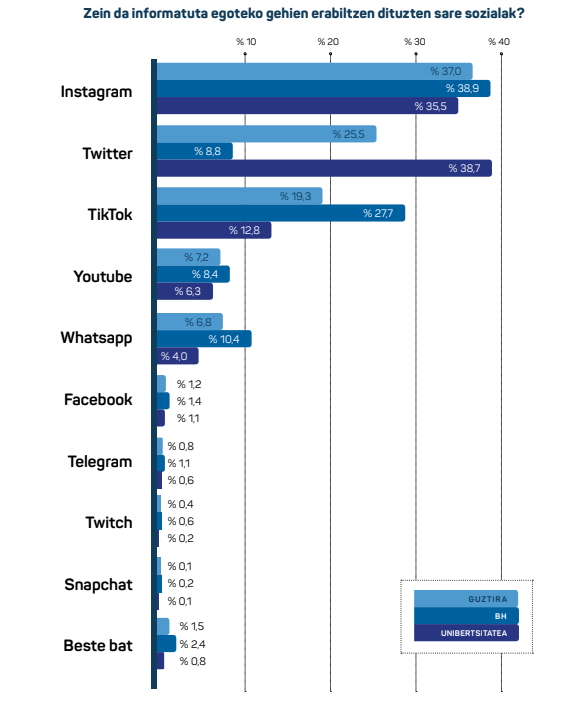
Next, students who report on social networks are asked what content they continue most (they are given the possibility to answer more than one). Just over half of the students indicate the contents that the main media disseminate on social networks (52.6%). The number of university students is even higher (63.1%).
46% mention the content generated by users of social networks and the contents of youtuber, instagramer or Tik Toker. 40.6% of older students say it and the percentage is higher among ES students (49%). Fourthly, there is the content that friends themselves take and share from the media (36.5%).
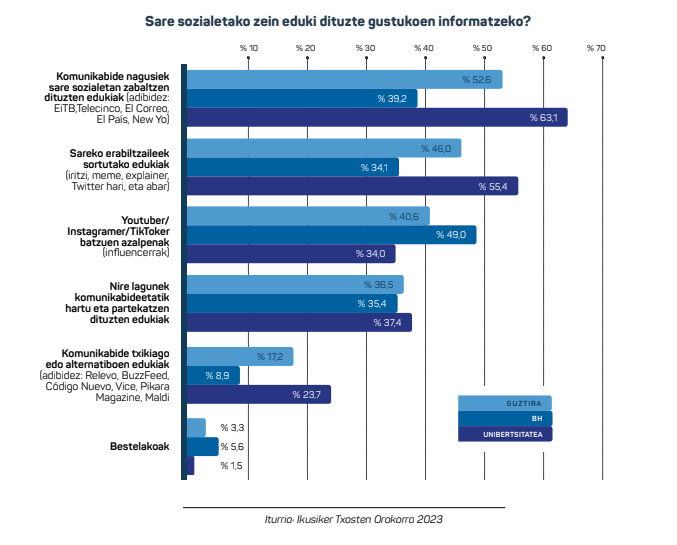
In social networks, asking about the information format they like the most, half of the students opt for story (48.7%), being especially high the percentage of ES students (59.9%). On the other hand, Twitter accounts for 27.5% of students and Twitter for 23.9%. The latter two show greater relevance among university students (40.3% and 32.5% respectively). Fourthly, the short videos made by a person watching the camera (21.4%) are selected and, fifthly, the news with images (21.3%)
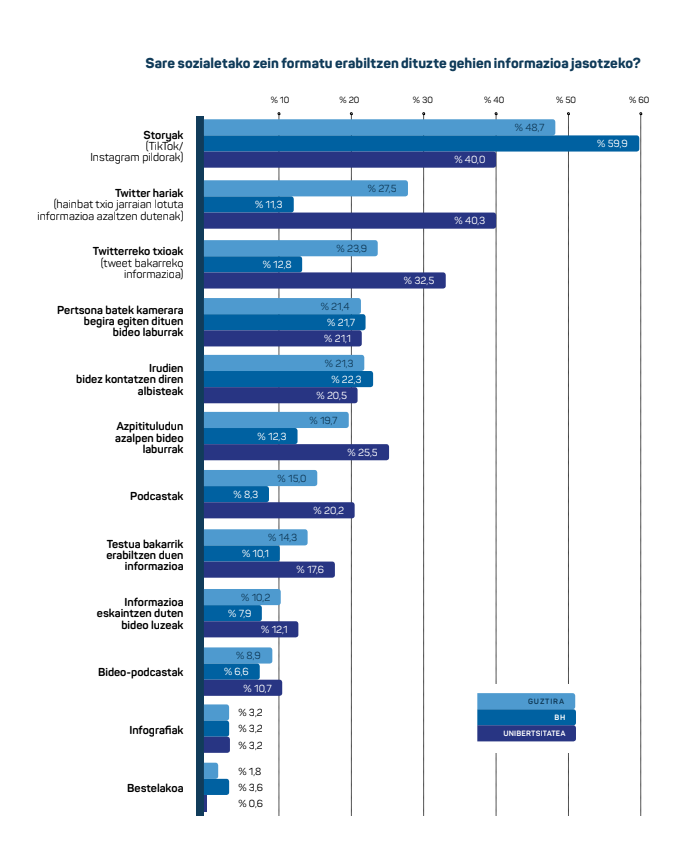
IN-DEPTH, UNIVERSITY AND INFORMATION
The Digital News Report 2023, published by Reuters Institute, notes that online consumers over 18 are increasingly less interested in news. Despite political and economic problems, less than half of the respondents (48%) said they saw the news with great or very high interest. In 2017 this group was 63%.
David Mindiche, Turned Out: Author of the book Why Americans Under 40 Don’t Follow the News (Oxford University Press, 2004), in an interview he said: ‘they are as smart and prepared as ever, what has changed is that young people no longer see the need to be up to date’.
These data and significant expressions have led us to deepen the behavior of the university students of the Ikusiker panel and to know if a greater adherence to information is expected for the elderly. But is it true?
In order to answer this question, the degree of interest in current information to these university students was first measured. Data from the general study show that the information is an interesting content for these young people from the UPV/EHU and the UPNA. If we meet the specifications, it is observed that the information is of sufficient interest for 46.9%. Only 1.6% say they do not take any action and 7.1% do not care too much.

The following analyzes the students" attitude towards collecting information, since the Reuters Institute report indicates that more and more students reject the information: Seven percent more than in 2017, but two points less than last year.

Therefore, when the university students of the Ikusiker panel are asked whether they have a habit of dispensing with information, 61.3% say that they do so "sometimes" and 12.6% say "to quite a few". 26.8% of respondents show a positive attitude towards information, so they never avoid news.
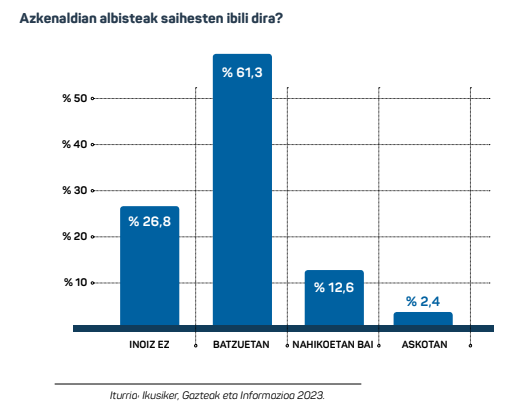
Being so significant the data of those who «sometimes» avoid information (61.3%), we enter into the causes of these results. One in three (31.5%) recognizes that there is currently an excess of information that bothers. 27.8% of panelists say they do not find the information they receive reliable and 15.8% say they love this type of content.

SHORT
The research Youth and Information carried out by Ikusiker in 2023 shows that social networks have become juvenile natural spaces to entertain, communicate and even be informed. Their weight as a source of information is increasing, especially among adolescents. Tik Tok is a reference network for high school students. Twitter is the main news channel for college students. Powerful networks have transformed their own forms of news production and, in this context, are creating news for formats adapted to the interests and needs of the new generations. Young people prioritize short videos, in the form of a story, and as for written information, being short in the form of a tweet is determinant for them. The audiovisual media is also an important element in bringing young people closer to information.
Our data also indicate that information is an area of interest for the University of the Southern Basque Country, according to half of the respondents. However, the same proportion says that they usually avoid information, as they receive too much information and annoy them.
The questionnaire that Ikusiker will conduct in the course 2023-2024 will tell us whether these information-related trends are maintained or undergoing changes.
REFERENCES
Arana, Edorta; Narbaiza, Bea; Sánchez, Garazi; Zorita, Itziar; Goirizelaia, Maialen (2023): Youth and information. IKUSIKER Audiovisual Observatory.
Arana, Edorta; Narbaiza, Bea; Sánchez, Garazi; Zorita, Itziar; Goirizelaia, Maialen (2023): Use of ICT and audio-visual of high school and university students. General Report 2022-2023. IKUSIKER Audiovisual Observatory.
Carr, Nicholas (2011). Superficial: Zer egiten ari da Internet Penguin Random House Editorial Group Spain.
Casero-Ripollés, A. (2012) Days agreement: the consumption of youth news in the digital age. Communicating, No 39, ISSN: 1134-3478: 151-158
Mindichek, Davis. (2004) Tuned Out: Why Americans Under 40 Don’t Follow the News. Oxford University Press.
Newman, N; Fletcher, Richard; Robertson, C.T; Eddy, K & Nielsen, R.K (2023). Reuters Institute Digital News Report.
Yuste, Bárbara (2020). The new forms of information of the Youth Studies venes.Revista, ISSN e 0211-4364. pp. 179-191.
1 Digital News Report 2023 analyzes new keys to digital news consumption worldwide. To do so, the YouGov survey was launched. Argentina, Australia, Austria, Belgium, Brazil, Bulgaria, Canada, Chile, Colombia, Croatia, Czech Republic, Denmark, Finland, France, Germany, Greece, Hong Cong, Hungary, India, Nigeria, United States, Southern Ireland, Italy Fieldwork for covert was conducted between late January 2022 and early February 2023.


